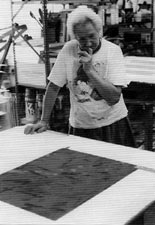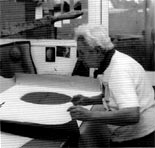 |
|
It's a Collaboration: An Interview with Sheila Marbain
By Sandy Walker
Sheila and Ary Marbain created Maurel Studios in 1955 in New York City as a custom screen printing shop specializing in printing with contemporary artists. From 1948 through 1950, Sheila studied at Black Mountain College in North Carolina with Joseph Albers, Ilya Bolotowsky, and Willem de Kooning; Ary worked and exhibited as a painter in France for many years. With the sudden death of Ary in 1963, the studio was closed for a year. Sheila decided to modernize the workshop with the introduction of screen photography and a new vacuum printing table. By 1965, Maurel Studios had reopened and Sheila was taking on the challenge of printing three-dimensional objects: a Plexiglas airship for Lichtenstein; an Oldenburg soft drum set; a set of dominoes with Fahlstrom; a large fabric banner with Marisol; and many other projects. She also worked collaboratively with Rauschenberg, Frankenthaler, Motherwell, Segal, and Wegman, to name only a few. Rutgers University's Zimmerli Art Museum organized an exhibition titled "Sheila Marbain as Master Printer: A Twenty-five Year Retrospective," honoring Marbain's considerable contribution to the screen printing medium, particularly its experimental aspects. Marbain's enthusiasm in helping artists to explore new aspects of printing led, in 1990, to the development of a technique of screen monoprinting. With this technique, the artist draws directly on taut silk with a wide variety of materials: graphite pencil, wax crayon, colored pencils, pastels, oil sticks, and so on. The image is then printed using a wax medium which both releases the pigment from the silk and transfers and seals it onto the paper. Encaustic is an ancient method of suspending pigments in wax and Marbain has now incorporated this medium within silkscreen printing. Wax is richly luminous and the resultant prints have a translucent quality. Marbain's screen monotype is unique, a process by which the artist can achieve effects distinctly different from those of any other monotype methods. Its simplicity encourages a spontaneous approach. I interviewed Sheila in her studio overlooking Canal Street in September 1999. At present her studio is in a corner of a larger print shop, Brand X Editions. Sandy Walker: Tell me what you said again, you would not let the artist have you make a separation? SM: Absolutely. I would insist that the artist give his or her own. I don't think it's right. It becomes a reproduction. It's not a print. And I don't do reproductions, I send them over to Brand X Editions. And what they are doing are reproductions. There's a distinct difference. For the artist, making a print should be as much of a creative effort as making any kind of original art, whether it's a painting or a drawing or whatever. The only difference is that the artist has the collaboration of the printer. SW: How would you define that collaboration? SM: It varies. The printer knows the techniques. It's the printer's job to give the artist as clear an image of how it will look or how it should proceed, as possible. It's the printer's job to open up areas. I used to show other prints to artists coming in, so that they could see the variety of choices that they had, and so they could get ideas of possible other ways of doing things. I show them as much as possible. I try to find out where the artist wants to go, and then I follow him or her. I'm probably one step behind all the time. SW: What about the fact that there are certain things that you've been doing for years and years and years. Lets say I come in here and I don't know how to do it at all. Even if you show me, I'm clumsy. There are things that I don't or can't do. SM: Not really, because the work you're doing is drawing or painting on the screen, as opposed to working directly on a piece of paper. It's really not much harder for you to do that. The only possible area where you run into problems is visualizing how it will look as a print. And I don't always know either. We have to explore. It's an exploration for both of us each time. I don't care how many times I've done it, it's always different. And that's what makes it interesting. If it became routine, I wouldn't care anymore. SW: So you're really interested in the creative moment. Printmaking is just another medium, just like any other instrument. SM: Exactly. I get a chance to share it, which is truly exciting. That's what it's all about. SW: I know exactly what you're talking about because I've worked with you. It's clear. But tell me, what do you think about editioning prints? SM: Once you've got the one proof, then the excitement is really over. It becomes a technical exercise, you try to keep the edition consistent and good. But it's a different avenue, it's a little more mechanical. You have to pay attention to all the details, and simply make sure that the original content is continued throughout the edition so it doesn't slack off or you don't lose interest. SW:That's "you" as the printer. SM: Yes. SW: When you're editioning, you take over, don't you? Does the artist still work with you on editioning? SM: It depends. Usually, the artist gives you the prototype and says, "I want a hundred of these." Generally there's enough trust, so I know what the artist wants and what can be done. SW: You and I haven't gotten involved in an editioning process, but if I wanted you to edition a print for me, I'm sure that I could not edition it as well as you. I'd have to be an apprentice for a long time. SM: I wouldn't expect that. I'm the printer. You hand it over to me. That's my job, and I will print it for you. There's no reason for you to print it, especially since, as you said, you couldn't do it as efficiently. It's mostly skill and experience, and paying attention. It isn't the same creative experience as it is in making the first proof. That's a different operation completely. Even Picasso used Mourlot and Sons-he would make his plates and Mourlot would print them. Picasso had no intention or any inclination to do his own printing. The same with his ceramics, he didn't mold the vase, he would change the shape maybe. It's a collaboration. SW: The whole production? SM: Yes, but on many different levels. There is the artisans' skill of printing, and there is the artist creating the image. SW: Well, would you say that there are printers and then there are printers, so to speak: high quality printers who are simply skilled at reproducing and then other printers who are more involved in the creative process? SM: Oh, absolutely, sure. SW: And would you create a hierarchy between those, or would you simply say that you like one better than the other? SM: There's a place for everybody. I'm also a highly skilled printer, but the ability to work with an artist is a very special one, and a very private and personal one, and often quite difficult. Maurel Studios is located at 75 Varick St., New York, NY 10013.
| ||||||||||||||||||||||||||||||||||||||||
| home | news | resume | bibliography | paintings | works on paper | wood block | silkscreen | statements | contact |

